|
- PR S1 - Review -
Text & Photos by Joel Navarro
Built with high quality throughout, this buggy is destined for greatness.
PERFORMANCE TEST HOBBY-PRO PRS1 1/10-SCALE ELECTRIC 2WD BUGGY KIT
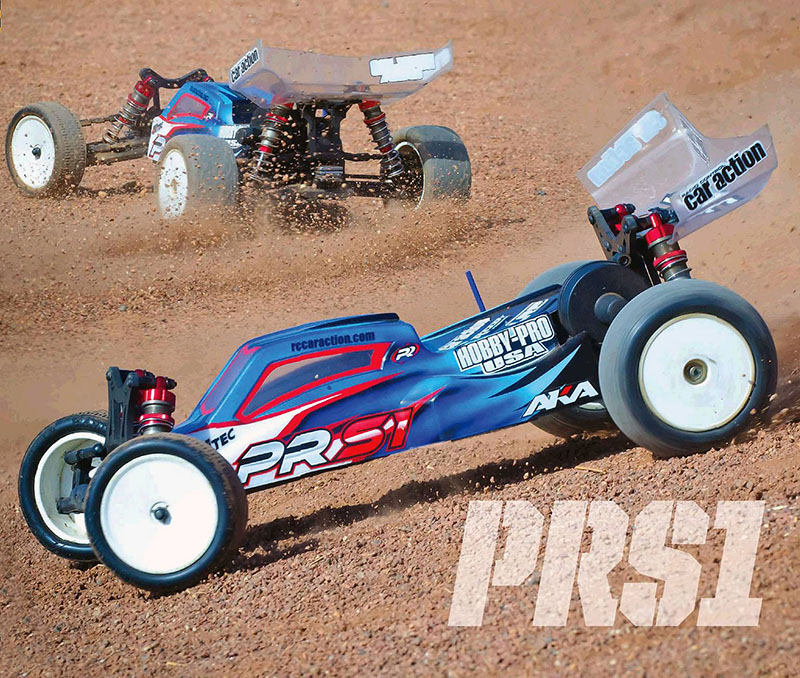
The constant influx of new brands and vehicles makes for an exciting landscape of competitive racing vehicles, particularly as different classes have waxed and waned in popularity. Hobby Pro USA’s new PRS1, their first 1/10-scale electric off-road kit, is a testament to the continuing strength of the 2WD buggy class that has been ranked as a favorite around the world. Until the PRS1’s release, Hobby Pro had been most active in the 1/8-scale market, but at first glance, it’s apparent that the high-quality treatment is carried over to the PRS1. There are many car companies that produce a “high-end” buggy that often leave out the choice stuff as an aftermarket option. This is not the case with the PRS1. Throughout the car, nothing but the best materials are used leaving you virtually no option to buy optional parts. Packed with features, the PRS1 sports a CNC hardened aluminum chassis that allows you to build this rig as a mid or rear motor, carbon-fiber shock towers and an abundance of suspension adjustment options that will allow you to adapt to virtually any track condition. Five-time national champion and Hobby Pro USA manager Andrew Smolnik has been causing havoc around local SoCal tracks with the PRS1, so I was anxious to see if I could do the same!
RACE-HUNGRY SUSPENSION
One glance at the PRS1’s suspension and you can quickly tell that the engineers did their homework and provided every adjustment you will ever need to dial in your ride without giving up anything to the other 2WD buggies currently on the market. The aluminum threaded shock bodies have a 12.75mm bore, making them among the largest in its class, and are coated for smooth piston movement while the top and bottom caps are red anodized to stand out. The lower H-arms are molded of nylon plastic that offer a slight bit of flex, which can help both the car’s drivability and durability. The camber links are easily accessible and be attached in a number of different inner and outer locations to alter camber link length and roll center. The carbon-fiber shock towers included in this kit were part of a promotional deal celebrating the release of the PRS1 and feature upper and lower shock mounting holes to alter the buggy’s ratio of up-travel versus down-travel.
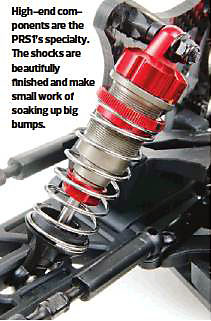
High-end components are the PRS1’s specialty. The shocks are beautifully finished and make small work of soaking up big bumps.
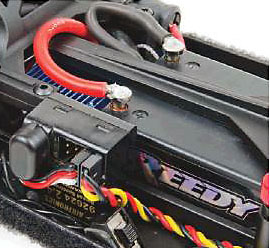
The PRS1 allows you to mount your speed control on the side trays or directly in front of the mid-mounted motor when using a shorty style battery.
DRIVETRAIN
The PRS1’s gearbox can be assembled with three or four gears, depending on whether the car will be built in rear- or mid-motor form. The differential is a ball type, which features a bulky diff screw that will ensure it will withstand the ballistic power of a modified motor. A dual-plate slipper clutch is easily accessible through a hole in the gear cover for easy adjustments in between runs. Because I planned to race the car in the 17.5 class where bit of drivetrain friction is a big no-no, I was pleased at how freely the transmission spun after simply being assembled according to the instructions. Power is transferred efficiently to the wheels via CV-style driveshafts with the outer pins captured in the hub bearings, which are rubber-sealed like those used throughout the PRS1.
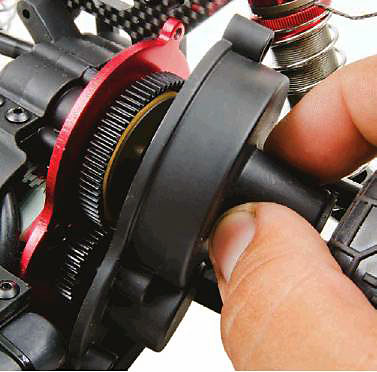
Change gears by removing the gear cover, or adjust the slipper clutch on the fly through the capped hole on the gear cover.
DUAL BELLCRANK STEERING
Navigating with precision is easy when driving the PRS1 through the trickiest sections of a track. The PRS1 uses a traditional dual bellcrank setup, which are constructed of stiff composite plastic to minimize flex and steering deflection. The steering rack attached to the bellcranks includes two different ackerman positions for added adjustment, while the steering block only has one hole.
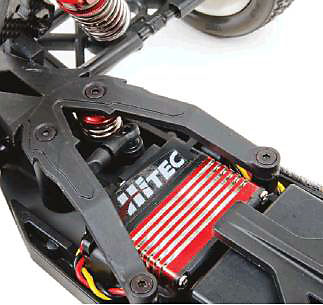
Left: This V-shaped brace supports the front of the chassis for an appropriate amount of rigidity where it really matters.
VERSATILE CHASSIS
In addition to being the solid backbone of the PRS1, the CNC hardened aluminum chassis yields no compromise in quality. Hobby Pro includes all you need to make the PRS1 a rear- or mid-motor car and only takes about half an hour to switch between the two configurations. Everything on the chassis is mounted as low as possible to help lower the center of gravity. Plastic chassis side guards mount to the chassis via ten countersunk screws, like you’d find on an 1/8-scale buggy, which in turn enhance lateral and torsional stiffness; the only drawback being there is limited space for regular-sized electronics.
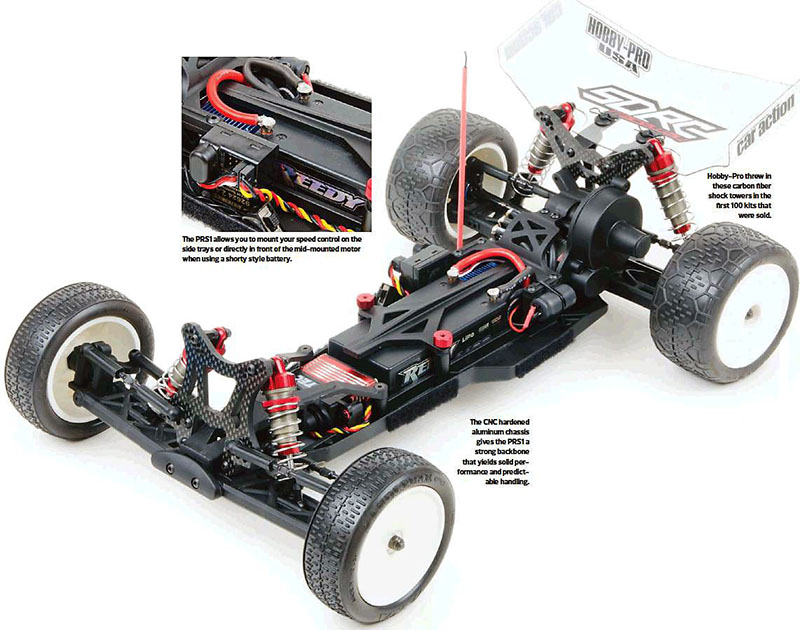
The CNC hardened aluminum chassis gives the PRS1 a strong backbone that yields solid performance and predictable handling. Hobby-Pro threw in these carbon fiber shock towers in the first 100 kits that were sold.
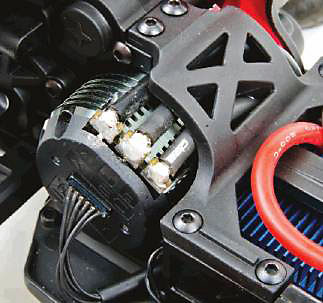
Above: The PRS1 in the mid-motor design carried excellent corner speed on SDRC Raceway’s clay. The car can be built with the motor in the rear, which is better for low-grip surfaces.
BEHIND THE WHEEL
I was eager to finish building the PRS1, and the second I did, I packed up my race gear and headed to SDRC Raceway (sdrcraceway.com) in Miramar, CA, for their regular Wednesday night racing program. I’m a fan of trying the box stock setup when I initially test a car because I know the engineers work with factory team drivers to settle on a setup that should put a new car in the ballpark, and this was true for the PRS1 as well. My initial impression of the box stock setup was a well-balanced car with a very neutral feel in the turns. When I got more familiar with the track layout, I pushed the car a little more and it started to reveal understeer when I initially entered a turn; another problem the PRS1 had was that it bottomed out when landing off the smallest jumps on the track. After later finding out that I had bled the shocks incorrectly (see the “Crash Course” sidebar), I quickly fixed my mistake and threw in a fresh battery. My initial settings on the PRS1 were 24mm right height, 1-degree of negative camber on all four corners and 0-degree of toe in the front. Back out on the track, the difference between my first and second runs was night and day. The suspension did a beautiful job of soaking up any and all imperfections on the track and breezed right through the washboard section without getting upset. Jumping the PRS1 was easy as it maintained straight and level flight while in the air and the bottoming out on landings problem had all but disappeared. I was on the third battery now, the AKA Handlebar tires were starting to break in and my lap times were only two seconds off the pace from the fast guys. On the previous run, the PRS1 still had a slight bit under steer, so to remedy the problem I had moved the rear shock position out one hole on the shock tower. The PRS1 now attacked the corners like it was on a mission to seek out the apex. The car’s ability to carry corner speed through the middle and exit of the turn was excellent, with more than enough rear grip as I got back on the power. Overall, it took very little effort to be competitive with the PRS1 as it only continued to get better in the weeks after my first race day with it.
The car’s ability to carry corner speed through the middle and exit of the turn was excellent.
+
Virtually no need to upgrade any parts
Rear or mid-motor option
No broken parts yet
Infinite adjustment
-
Limited space for electronics
More front kick-up options should be standard
VEHICLE SPECS
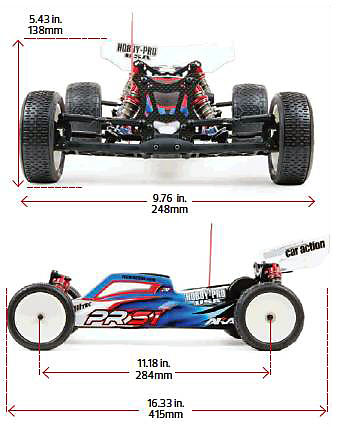
Item no.: HPRO66401447
Scale: 1/10
Price: $289
Width: 9.76 in. (248mm)
Height: 5.43 in. (138mm)
Length: 16.33 in. (415mm)
Wheelbase: 11.18 in. (284mm)
Weight: 3.37 lb. (1530g)
Chassis: CNC Hardened Aluminum
SUSPENSION
Type:Lower H-arm with turnbuckle camber link
Inboard camber link positions (F/R) 7/1
Outboard camber link positions (F/R) 2/2
Shock positions, towers (F/R) 8/7
Shock positions, arms (F/R) 2/2
SHOCKS
Bodies: Threaded aluminum, 12.75mm bore
Shafts: 3mm
Volume compensation: Bladder
DRIVETRAIN
Type/Ratio: Three- or four-gear transmission with ball differential/2.6:1
Slipper Clutch: 2-plate adjustable type
Differential: Ball type
Driveshafts: CV-style universals
Bearings: Rubber sealed
WHEELS AND TIRES
Wheels: One-piece dish with standard 12mm hex
Tires: Not included
Body: Clear Lexan type/clear Lexan wing (shown here painted by Fatty Grafx, fattygrafx.com)
TEST EQUIPMENT
Speed control: LRP Flow Works Team (#80970, $200)
Battery: Reedy 4100mAh Shorty LiPo (#602, $90)
Servo: Hitec HSB-9360TH (#39630, $180)
Motor: LRP Vector X20 17.5-turn (#50854, $90)
Tires: AKA Handlebar, Super Soft Front (13202V, $15) Rear (13110V, $15)
CRASH COURSE
Proper Rebound
The shocks on the PRS1 use a rubber bladder to compensate for the volume displaced by the shock piston and shaft, which starts to collapse as the shock is compressed. One important thing you need to be aware of is setting your rebound amount when you build/rebuild your shock. It’s really quite a simple process: before you place the bladder on the top side of the shock body to bleed any excess oil, push up the shock shaft to the desired rebound followed; then mount the bladder followed by the shock cap. On a bumpy track, you generally want more rebound to allow the suspension to recover quickly from bumps. Use less rebound if you’re running on a high bite track to make the car smoother and easier to drive.
FINAL WORD
The Hobby-Pro PRS1 has earned a place among my favorite race cars. Out of the box it was instantly a strong performer, and it only got better with every small suspension tweak I made and with every run I put on it. With all the manufacturers pushing the progression of 1/10-scale 2WD buggies to the next level, the only winner in the end is the racer. The PRS1 is a product of this progress; there is very little this buggy lacks in adjustment and possesses all the attributes a buggy must have to be successful on the track. The PRS1 is ready to take you to the next level.
SOURCES:
AKA Racing raceaka.com
Fatty Grafx fattygrafx.com
Hitec RCD hitecrcd.com
Hobby-Pro USA hobbyprousa.com
LRP LRP.cc
Reedy rc10.com
SDRC Raceway sdrcraceway.com
Source:

|
